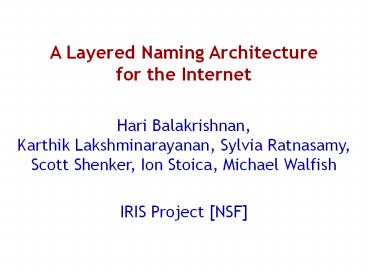A Layered Naming Architecture for the Internet - PowerPoint PPT Presentation
Title:
A Layered Naming Architecture for the Internet
Description:
... (SIDs) are host-independent data names. End-point identifiers (EIDs) are location-independent host names ... Flat names impose no structure on entities ... – PowerPoint PPT presentation
Number of Views:110
Avg rating:3.0/5.0
Title: A Layered Naming Architecture for the Internet
1
A Layered Naming Architecture for the Internet
- Hari Balakrishnan, Karthik Lakshminarayanan,
Sylvia Ratnasamy, Scott Shenker, Ion Stoica,
Michael Walfish - IRIS Project NSF
2
Architectural Discontents in Todays Internet
- Lack of features
- End-to-end QoS, host control over routing,
end-to-end multicast, - Lack of protection and accountability
- Denial-of-service (DoS)
- Architecture is brittle
3
Architectural Brittleness
- Hosts are tied to IP addresses
- Mobility and multi-homing pose problems
- Services are tied to hosts
- A service is more than just one host
replication, migration, composition - Packets might require processing at
intermediaries before reaching destination - Middleboxes (NATs, firewalls, )
4
Naming Can Help
- Our thesis proper naming can cure some ills
- Layered naming provides layers of indirection and
shielding - Many proposals advocate large-scale, overarching
architectural change - Routers, end-hosts, services
- Our proposal
- Changes only hosts and name resolution
- Synthesis of much previous work
5
Internet Naming is Host-Centric
- Two global namespaces DNS and IP addresses
- These namespaces are host-centric
- IP addresses network location of host
- DNS names domain of host
- Both closely tied to an underlying structure
- Motivated by host-centric applications
6
The Trouble with Host-Centric Names
- Host-centric names are fragile
- If a name is based on mutable properties of its
referent, it is fragile - Example If Joes Web page www.berkeley.edu/hippi
e moves to www.wallstreetstiffs.com/yuppie, Web
links to his page break - Fragile names constrain movement
- IP addresses are not stable host names
- DNS URLs are not stable data names
7
Key Architectural Questions
- Which entities should be named?
- What should names look like?
- What should names resolve to?
8
Name Services and Hosts Separately
- Service identifiers (SIDs) are host-independent
data names - End-point identifiers (EIDs) are
location-independent host names - Protocols bind to names, and resolve them
- Apps should use SIDs as data handles
- Transport connections should bind to EIDs
Binding principle Names should bind protocols
onlyto relevant aspects of underlying structure
9
The Naming Layers
User-level descriptors(e.g., search)
App-specific search/lookup returns SID
App session
Resolves SID to EIDOpens transport conns
Transport
Resolves EID to IP
IP
10
Key Architectural Questions
- Which entities should be named?
- What should names look like?
- What should names resolve to?
11
SIDs and EIDs should be Flat0xf436f0ab527bac9e8b1
00afeff394300
Stable-name principle A stable name should not
impose restrictions on the entity it names
- Flat names impose no structure on entities
- Structured names stable only if name structure
matches natural structure of entities - Can be resolved scalably using, e.g., DHTs
- Flat names can be used to name anything
- Once you have a large flat namespace, you never
need other global handles
12
Flat Names Enable Flexible Migration
- SID abstracts all object reachability information
- Objects any granularity (files, directories)
- Benefit Links (referrers) dont break
Domain H
HTTP GET /docs/pub.pdf
10.1.2.3
ltA HREF http//f012012/pub.pdf gthere is a
paperlt/Agt
/docs/
HTTP GET /user/pubs/pub.pdf
Domain Y
20.2.4.6
(10.1.2.3,80, /docs/)
/user/pubs/
(20.2.4.6,80, /user/pubs/)
ResolutionService
13
Flat Names are a Two-Edged Sword
- Global resolution infrastructure needed
- Perhaps as managed DHT infrastructure
- Lack of local name control
- Lack of locality
- Not user-friendly
- User-level descriptors are human-friendly
14
Key Architectural Questions
- Which entities should be named?
- What should names look like?
- What should names resolve to?
15
Delegation
- Names usually resolve to location of entity
- Packets might require processing at
intermediaries before reaching destination - Such processing today violates layering
- Only element identified by packets IP
destination should inspect higher layers
Delegation principle A network entity should be
able to direct resolutions of its name not only
to its ownlocation, but also to chosen delegates
16
Delegation Enables Architecturally-Sound
Intermediaries
Resolution svc
EID d IP ipd
EID s
- Delegate can be anywhere in the network, not
necessarily on the IP path to d (ipd) - SID/EID can resolve to sequence of delegates
17
Application-Layer Intermediaries
Resolution svc
fmid is SID for composed service
EID s
Mail serverSID ms
Goal Email to user must traversespam filter en
route to mail server
18
Related Work
- Most direct inspiration HIP i3 SFR
- Prototype Delegation-Oriented Arch. (DOA)
- EID proposals Nimrod, HIP, Peernet
- Mobility/multihoming Mobile IP, IPv6, Migrate
- Intermediaries IPNL, TRIAD, UIP, P6P, MIDCOM
- SID-like proposals URNs, Globe, ONH
- Other architecture proposals
- PIP, Nimrod, IPv6, Active Networks,
- FARA, Smart Packets, Network Pointers, Predicate
Routing, Role-based Architecture
19
Take-Home Points
- Flat names are now plausible
- Two flat naming layers fix brittleness
- SIDs and EIDs
- Delegation is a powerful primitive
20
The Future?
- With flat SID/EID delegation
- Like hosts, data becomes first-class entity
- Middleboxes gracefully accommodated
- IP will continue to be a rigid infrastructure
- But naming is more malleable and can reduce
architectural brittleness - Deployment requires
- Changes to hosts
- Global resolution infrastructure































